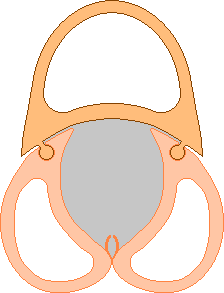Most non-beekeeping people consider bees to be a problem, they have a pointed bit at the rear end which in the minds of the general public (and some novice beekeepers) they will use at every possible opportunity. This is far from true and even if you are stung it is not much different from pricking your finger on a blackberry thorn or a rose bush. The sting itself is a small, efficient, well engineered device that allows the bee to defend it's own life and it's nest, against predators. Structure of the StingThe abdomen of the honeybee has 10 segments, seven of which are obvious, the first one... A1 is called the propodeum and is attached to the thoracic segments and is better described as part of the thorax, the remaining part is known as the gaster and outwardly appears to have six segments, the last of these being A7, The remaining three segments are internal inside A7. In some other members of the Hymenoptera A8 &A9 becomes an ovipositor, (some of these ovipositors drill into wood in a similar fashion to that which the honey bee's sting penetrates skin).
The sting mechanism is shown flat above, for ease of understanding, it is actually much more compact and folded, as the small lateral diagram shows at right. Comparable structures are coloured the same in both views. The left side shows the protractor muscle and is in the protracted position and on the right hand side the retractor muscle is shown with the right hand lancet retracted. Note that the forward moving umbrella valve collects venom while the retracting one collapses. The Parts of the StingThe cavity within A7 is called the sting chamber and the whole of the sting apparatus is enclosed within it when not in use. The apparatus consists of three pairs of plates, oblong (light yellow), quadrate (strong yellow)and triangular (dark brown). Two pairs of protractor and retractor muscles move the quadrate plates up and down which causes the triangular plate to act as a rocker, converting linear motion of the quadrate plate into a curved motion in the ramus (a flexible extension of the lancet). Thus the two lancets are advanced in an alternating fashion, which gives rise to a vibration that can be felt by the person being stung. All of this movement takes place against the oblong plates which form a rigid armature for the muscles to act against and the triangular plate to pivot about. The path that the ramus transcribes is also constrained to a semicircular track by appendages to the oblong plates.

The shaft of the sting consists of three hollow sharply pointed structures which mesh together rather like the closure of a 'zip-lock' plastic bag to surround a central canal. These are the left and right lancets (which are barbed) and the central dorsal stylet. The stylet at its inner end becomes larger and softer, this structure, known as the bulb, is the reservoir for the venom. It has a pair of 'umbrella' valves to push venom down into the shaft as it is forced into the victim. The venom sac and glands that produce other secretions are connected to the bulb. The darker component, in the cross sectional drawing at right, is the stylet and the grey area is the central canal along which the venom is delivered. Each of the three components is incredibly stiff, by virtue of the cross sectional shape. (Rolling a sheet of paper around a pencil, to form a tube, increases it's stiffness many times.) The Action of StingingWhen the sting is deployed, the bee bends it's abdomen downward due to the actions of the muscles that connect the abdominal plates. The muscle set on the ventral side contracts thereby increasing the overlap between the sternite plates. On the dorsal side another set of muscles contract so that the membrane between the tergite plates is distended. This results in a bent abdomen, which in combination of the angular ventral movement of the sting shaft (in turn caused by the furcula muscle). This ensures that the sting shaft enters roughly perpendicularly into skin of the victim. Perpendicular penetration is the most efficient as venom is delivered more deeply and the path through the tough skin is shortest. The force from the bee's legs, the muscles of the abdomen and the effect of the backward raked barbs, as the lancets reciprocate alternately, all combine to produce a thrust that drives the penetration of the sting. Venom is pumped into the central canal by the reciprocating action of the lancets, each of which has an umbrella like collector and valve (within the liquid contained in the bulb) The pulses of venom are delivered through the canal and squeeze out between the rubbing faces of the two lancets. This is another feature that is of high efficiency as the venom comes into contact with a much larger area of tissue than would be the case if the sting were similar to a hypodermic needle. The venom also leaks to a small extent from the exposed portion of the sting shaft providing a pheromone alert at the earliest possible moment.
This oblique drawing shows the action of the lancets sliding on the rails of the stylet. The grey outline is that of a needle tip and is to similar scale. The portion shown is approximately half a millimetre long and indicates that the sting will penetrate much more readily than a needle (and we all know how sharp needles are!).
The diagrams have been drawn by reference to many different drawings and photographs, they are most similar to those found in H.A. Dade's Book "Anatomy and Dissection".
|
Tidak ada komentar:
Posting Komentar